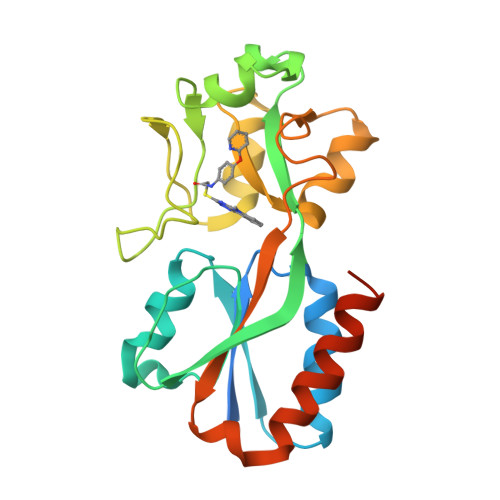Hit Identification of New Potent PqsR Antagonists as Inhibitors of Quorum Sensing in Planktonic and Biofilm GrownPseudomonas aeruginosa.
Soukarieh, F., Liu, R., Romero, M., Roberston, S.N., Richardson, W., Lucanto, S., Oton, E.V., Qudus, N.R., Mashabi, A., Grossman, S., Ali, S., Sou, T., Kukavica-Ibrulj, I., Levesque, R.C., Bergstrom, C.A.S., Halliday, N., Mistry, S.N., Emsley, J., Heeb, S., Williams, P., Camara, M., Stocks, M.J.(2020) Front Chem 8: 204-204
- PubMed: 32432073
- DOI: https://doi.org/10.3389/fchem.2020.00204
- Primary Citation of Related Structures:
6TPR - PubMed Abstract:
Current treatments for Pseudomonas aeruginosa infections are becoming less effective because of the increasing rates of multi-antibiotic resistance. Pharmacological targeting of virulence through inhibition of quorum sensing (QS) dependent virulence gene regulation has considerable therapeutic potential. In P. aeruginosa , the pqs QS system regulates the production of multiple virulence factors as well as biofilm maturation and is a promising approach for developing antimicrobial adjuvants for combatting drug resistance. In this work, we report the hit optimisation for a series of potent novel inhibitors of PqsR, a key regulator of the pqs system, bearing a 2-((5-methyl-5 H -[1,2,4]triazino[5,6- b ]indol-3-yl)thio) acetamide scaffold. The initial hit compound 7 (PAO1-L IC 50 0.98 ± 0.02 μM, PA14 inactive at 10 μM) was obtained through a virtual screening campaign performed on the PqsR ligand binding domain using the University of Nottingham Managed Chemical Compound Collection. Hit optimisation gave compounds with enhanced potency against strains PAO1-L and PA14, evaluated using P. aeruginosa pqs -based QS bioreporter assays. Compound 40 (PAO1-L IC 50 0.25 ± 0.12 μM, PA14 IC 50 0.34 ± 0.03 μM) is one of the most potent PqsR antagonists reported showing significant inhibition of P. aeruginosa pyocyanin production and pqs system signaling in both planktonic cultures and biofilms. The co-crystal structure of 40 with the PqsR ligand binding domain revealed the specific binding interactions occurring between inhibitor and this key regulatory protein.
Organizational Affiliation:
School of Life Sciences, University of Nottingham Biodiscovery Institute, University of Nottingham, Nottingham, United Kingdom.



















